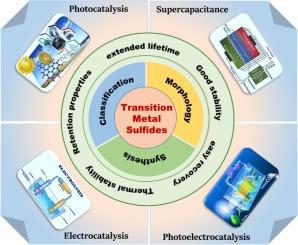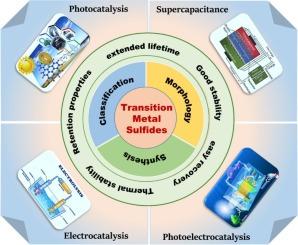过渡金属硫化物:从设计策略到环境和能源相关应用
IF 20.3
1区 化学
Q1 CHEMISTRY, INORGANIC & NUCLEAR
引用次数: 0
摘要
在过去几年中,对过渡金属硫化物(TMSs)材料组成的纳米晶体的科学研究明显增加。这种浓厚的兴趣源于它们在环境保护和推进可再生能源解决方案方面的潜在应用。这在很大程度上归功于大量可随时调节电子光学、物理和化学特性的材料。TMS 代表半导体化合物,其中硫作为阴离子与金属阳离子配位。这些化合物可以呈现单、双或多种形式的金属离子。范围广泛的 TMSs 材料提供了一个独特的框架,可生成无数潜在的材料,展示出各种化学、物理和电子现象,以及创新的可用特性和应用。要释放这些迷人材料的全部潜能,就必须开发可扩展的技术,以制造具有成本效益的 TMS、异质结构和高质量的混合材料。本综述阐述了精确制造 TMSs 的方法,随后研究了通过各种材料制造技术实现的 TMSs 纳米晶体的最新形态。本研究强调了各种基于金属硫化物的纳米光催化剂在高效降解有毒有机污染物、抗生素和染料方面的显著贡献。此外,研究还详细探讨了它们在水分离制取氢燃料方面的作用,具体说明了含有 TMSs 纳米晶体的纳米复合材料中的不同电荷转移机制。此外,还详细介绍了基于 TMSs 的电极在电催化和光电催化水分离、二氧化碳还原、能量存储和超级电容方面的作用,以应对能源危机。最后,本综述文章从未来的角度讨论了基于 TMSs 的半导体的一些不足之处。我们希望这篇综述文章能为污染物降解、能源生成和存储提供新的方向,以减少全球变暖的影响。本文章由计算机程序翻译,如有差异,请以英文原文为准。


Transition metal sulfides: From design strategies to environmental and energy-related applications
Over the preceding years, there has been a notable rise in scientific inquiry focused on nanocrystals composed of transition metal sulfides (TMSs) materials. This heightened interest stems from their potential applications in environmental conservancy and the advancement of renewable energy solutions. This is largely attributed to the plentiful availability of materials with readily adjustable electronic-optical, physical, and chemical characteristics. TMSs represent semiconducting compounds wherein sulfur functions as the anion coordinated with a metal cation. These compounds can exhibit mono-, bi-, or multiple forms of metal ions. The extensive range of TMSs materials offers a distinctive framework for generating a myriad of potential materials showcasing diverse chemical, physical, and electronic phenomena, along with innovative serviceable characteristics and applications. Unlocking the complete potential of these captivating materials necessitates the development of scalable techniques for fabricating cost-effective TMSs, heterostructures, and high-quality hybrids. This inclusive review delineates methodologies for the precise fabrication of TMSs, followed by an examination of the recent morphologies of TMSs nanocrystals achieved through various material fabrication techniques. This study highlights the notable contribution of various metal-sulfide-based nano-photocatalysts in efficiently degrading toxic organic pollutants, antibiotics, and dyes. Additionally, a detailed exploration of their role in water splitting for hydrogen fuel has been presented by specifying different charge transfer mechanisms in nanocomposites containing TMSs nanocrystals. Furthermore, TMSs-based electrodes for electrocatalytic and photoelectrocatalytic water splitting, carbon dioxide reduction, energy storage, and supercapacitance have been chartered in detail to cope with energy crises. Finally, some shortcomings of TMSs-based semiconductors are discussed from a future perspective in this review article. We hope this review article presents new directions for pollutant degradation, energy generation, and storage to reduce the impacts of global warming.
求助全文
通过发布文献求助,成功后即可免费获取论文全文。
去求助
来源期刊

Coordination Chemistry Reviews
化学-无机化学与核化学
CiteScore
34.30
自引率
5.30%
发文量
457
审稿时长
54 days
期刊介绍:
Coordination Chemistry Reviews offers rapid publication of review articles on current and significant topics in coordination chemistry, encompassing organometallic, supramolecular, theoretical, and bioinorganic chemistry. It also covers catalysis, materials chemistry, and metal-organic frameworks from a coordination chemistry perspective. Reviews summarize recent developments or discuss specific techniques, welcoming contributions from both established and emerging researchers.
The journal releases special issues on timely subjects, including those featuring contributions from specific regions or conferences. Occasional full-length book articles are also featured. Additionally, special volumes cover annual reviews of main group chemistry, transition metal group chemistry, and organometallic chemistry. These comprehensive reviews are vital resources for those engaged in coordination chemistry, further establishing Coordination Chemistry Reviews as a hub for insightful surveys in inorganic and physical inorganic chemistry.
 求助内容:
求助内容: 应助结果提醒方式:
应助结果提醒方式:


